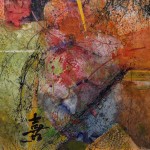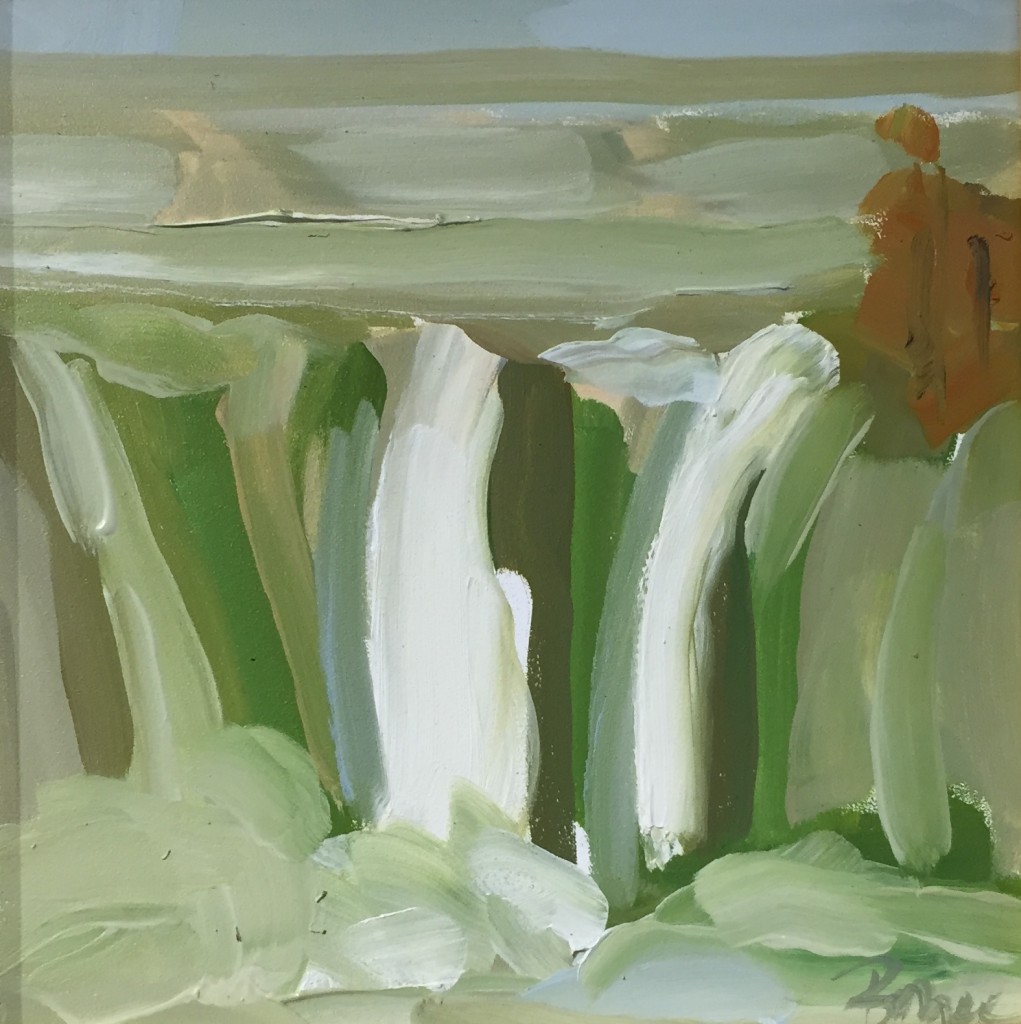Pushing paint
There’s a great show in its final days at Oxford Gallery, abstractions from two artists whose work took me by surprise. The invitation card didn’t convey how effective their best paintings are, and, as usual, the work was powerful insofar as I was mystified by what exactly enabled their imagery to succeed. I’d seen Phyllis Bryce Ely’s work before, when it won an award in the Memorial Art Gallery’s biennial Finger Lakes Exhibition in 2013. I admired her style without finding myself arrested by it as I walked around the exhibit back then. This time, I found myself coming back many times to particular paintings, seeing more as I stayed with it. Her work hovers right on the cusp between representation and abstraction. It’s always a distillation of a landscape, often involving swirling or falling water. This time, moving from one painting to another, I was reminded of both Charles Burchfield and Arthur Dove, yet her work departs from both influences. Where these two earlier artists were more concerned with careful depiction of a heightened vision of nature, Ely wants to create and convey a quiet energy by giving priority to the paint itself, making visible the way it flows from her brush, creating line and form with the edges of her strokes and slightly unpredictable modulations of tone that flow from the brush as it moves. (Many artists try to paint this loosely; it takes a gift to make it work as consistently as Ely does.) It gives her a special affinity with the subject of moving water–her paint seems a slow, loping doppleganger of the rushing flow it enables you to see. She’s very much in your face about how she pushes paint around. It’s the first thing that meets the eye, before your eye resolves the paint into a scene. Her most effective work looks as if, with Welliver, there’s not much “going back over” for her. So she’s also in a zone between what’s spontaneous and what’s calculated, and yet despite this irrevocable quality in how she applies the paint, the effects are often amazingly evocative–she’s still rendering a scene, with subtle effects of depth and distance, inspiring you to feel there’s more detail in the image than is actually there. With so much emphasis on the surface, and the quality of the paint, you still have a distinct and subtle assurance of a hazy, glowing light source. Or to put it in layman’s terms: you clearly see the, uh, sunlight. It’s remarkable. She makes you imagine more than she requires herself to show, which is the magic of painting at its best. Her technical mastery, from one painting to another, conveys a vision of nature in turbulent motion, but going nowhere in particular, an illuminated world giving a cold shoulder to the eye that eagerly takes it in.
 Todd Chalk, of Buffalo, has included some of her latest work–I counted three different personal modes. Some are more conventional abstracts. One especially powerful and effective small painting represents a glance upward through bare branches into an illuminated sky–it’s one of the best pieces in the whole show–and, finally, a series of square watercolors on yupo paper. I confess I’d never heard of that paper before, but it sounds like the perfect support for the green-minded crowd: synthetic, yet recyclable and “100% tree-free” as a promotional website puts it. I love it when artists explore unusual materials, and in this case, the qualities of what seems to be primarily an industrial paper made her intricate, small abstracts fresh, crisp and vibrantly colored. Watercolor on waterproof paper suggests an unconsummated tension as paint and paper fail to merge. She puts that romantic suspense to use: by keeping all the pigment right on the white surface it adds a special intensity to her beautiful explorations of color. Chalk has created a suite of improvisations with color and form, composing intricate Klee-like inner worlds as layered with overlapping tones as a looping song. For an artist thriving and innovating into her eighth decade–if her listed birthdate is true–these paintings offer hope for all of us embarking into the final third of our lives.
Todd Chalk, of Buffalo, has included some of her latest work–I counted three different personal modes. Some are more conventional abstracts. One especially powerful and effective small painting represents a glance upward through bare branches into an illuminated sky–it’s one of the best pieces in the whole show–and, finally, a series of square watercolors on yupo paper. I confess I’d never heard of that paper before, but it sounds like the perfect support for the green-minded crowd: synthetic, yet recyclable and “100% tree-free” as a promotional website puts it. I love it when artists explore unusual materials, and in this case, the qualities of what seems to be primarily an industrial paper made her intricate, small abstracts fresh, crisp and vibrantly colored. Watercolor on waterproof paper suggests an unconsummated tension as paint and paper fail to merge. She puts that romantic suspense to use: by keeping all the pigment right on the white surface it adds a special intensity to her beautiful explorations of color. Chalk has created a suite of improvisations with color and form, composing intricate Klee-like inner worlds as layered with overlapping tones as a looping song. For an artist thriving and innovating into her eighth decade–if her listed birthdate is true–these paintings offer hope for all of us embarking into the final third of our lives.

Comments are currently closed.